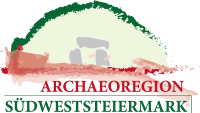For more than 140 years, the Universalmuseum Joanneum has been carrying out excavations in Wagna and has devoted itself to the processing of previously excavated finds. After Richard Knabl had identified the Roman town west of the market town of Wagna as Flavia Solva, Friedrich Pichler was the first to carry out scientific excavations as curator of the Joanneum in 1877/78.
From 1911 to 1918, the regional archaeologist Walter Schmid excavated large parts of the city with the help of prisoners of war. The first map of the city and the naming of the insulae (blocks of houses) and the streets, which were up to 20 m wide, can be traced back to him. Schmid’s successor at the Joanneum, Walter Modrijan, was confronted with a building boom in the post-war period and the accompanying emergency excavations. The logging of observations during these years was also the responsibility of Eduard Staudinger, a secondary school teacher from Leibnitz, who was a corresponding member of the Historical Commission for Styria. Between 1949 and 1989, Staudinger recorded in hundreds of protocols, sketches and images what he observed in Wagna and what the population, especially pupils, reported to him. The protocols have been preserved as originals and copies in the Joanneum Universal Museum, in the Federal Monuments Authority, but also in private archives.
Staudinger and the surveyor Alexander Legat succeeded in reconciling the town plan, which goes back to Walter Schmid, with the plot plan of Wagna, thus making it possible to record current observations with pinpoint accuracy. From 1970 to 2002, the excavation director was Erich Hudeczek, whose life’s work in Flavia Solva led to numerous publications and culminated in the 2004 exhibition “The Romans”. In 2007, the Joanneum under Barbara Porod resumed the excavations. In 2011, they had to be discontinued for the time being. A desideratum for the future is the processing of the excavated finds.
Flavia Solva: An important contribution to the regionalization of the Joanneum Universal Museum
Since 2004, archaeological finds that tell of life in the ancient city have been presented to the public in the newly constructed Flavia Solva pavilion. The building – designed by the Graz-based architectural firm Nussmüller – floats on six pillars above the ruins of Insula XXII and places the exhibits in close relation to their original site of discovery. The integration of the ancient surroundings makes it a transparent place that brings visitors unusually close to life in the ancient city, and thus it also – and not only in its architectural construction – represents a bridge from the present to the ancient past of Styria. With the construction of the exhibition building in Flavia Solva, the Joanneum Universal Museum has taken a step towards regionalization. In 2012, the exhibition and the outdoor area were redesigned, and the gastronomic partner Café Koppitz has significantly increased the attractiveness of the location. This unique combination of culinary delights and knowledge transfer goes hand in hand with low-threshold offers, such as the annually changing showcase into the Roman era. For the future, a closer cooperation with the people of Wagna is aspired for a comprehensive research of the Roman city.
Flavia Solva: training center for archaeologists
For about 40 years until 2011, the Joanneum Universal Museum, Department of Archaeology and Coin Cabinet, carried out research excavations during the summer months as teaching excavations of the Institute of Archaeology of the Karl Franzens University Graz. There is hardly an archaeologist in Styria who did not spend a summer in Flavia Solva. Numerous final theses resulted from this fruitful partnership with the university.
Flavia Solva: A Reader
A summary of the results of 100 years of research in Flavia Solva can be found in the 2010 book “Flavia Solva. A Reader.” This “Solva Anthology” is not intended as an exhibition catalog, but as a reading book in which the city of Flavia Solva is presented beyond its significance as part of the Roman Empire as a microcosm with specific characteristics. For this purpose, ten authors have agreed to write texts about Flavia Solva in their respective fields of expertise.
The reader can be ordered here: https://phoibos.at.
Here you can learn interesting facts about the oldest city in Styria free of charge, around the clock, 365 days a year. Walk around the pavilion – a showcase into Roman times – or stroll around the archaeological site! Interesting facts are available at several points.
Contact:
Marburgerstraße 111, A-8435 Wagna
T: +43 316 8017 9560, archaeologie@museum-joanneum.at
www.museum-joanneum.at/flavia-solva
Text: Mag.a Dr.in Barbara Porod

